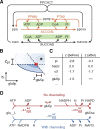Probabilistic thermodynamic analysis of metabolic networks
- PMID: 33755125
- PMCID: PMC8479673
- DOI: 10.1093/bioinformatics/btab194
Probabilistic thermodynamic analysis of metabolic networks
Abstract
Motivation: Random sampling of metabolic fluxes can provide a comprehensive description of the capabilities of a metabolic network. However, current sampling approaches do not model thermodynamics explicitly, leading to inaccurate predictions of an organism's potential or actual metabolic operations.
Results: We present a probabilistic framework combining thermodynamic quantities with steady-state flux constraints to analyze the properties of a metabolic network. It includes methods for probabilistic metabolic optimization and for joint sampling of thermodynamic and flux spaces. Applied to a model of Escherichia coli, we use the methods to reveal known and novel mechanisms of substrate channeling, and to accurately predict reaction directions and metabolite concentrations. Interestingly, predicted flux distributions are multimodal, leading to discrete hypotheses on E.coli's metabolic capabilities.
Availability and implementation: Python and MATLAB packages available at https://gitlab.com/csb.ethz/pta.
Supplementary information: Supplementary data are available at Bioinformatics online.
© The Author(s) 2021. Published by Oxford University Press.
Figures





References
-
- Abernathy M.H. et al. (2019) Comparative studies of glycolytic pathways and channeling under in vitro and in vivo modes. AIChE J., 65, 483–490.
-
- Bélisle C.J. et al. (1993) Hit-and-run algorithms for generating multivariate distributions. Math. Oper. Res., 18, 255–266.
-
- Desouki A.A. et al. (2015) Cyclefreeflux: efficient removal of thermodynamically infeasible loops from flux distributions. Bioinformatics, 31, 2159–2165. - PubMed
Publication types
MeSH terms
Grants and funding
LinkOut - more resources
Full Text Sources
Other Literature Sources

